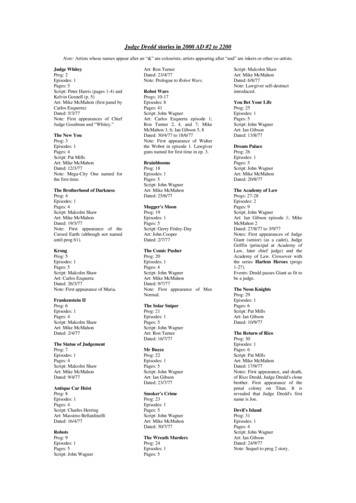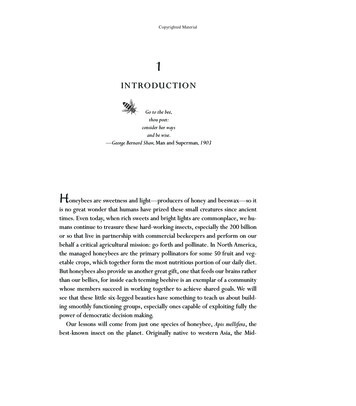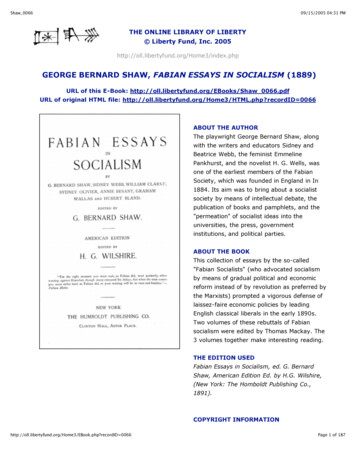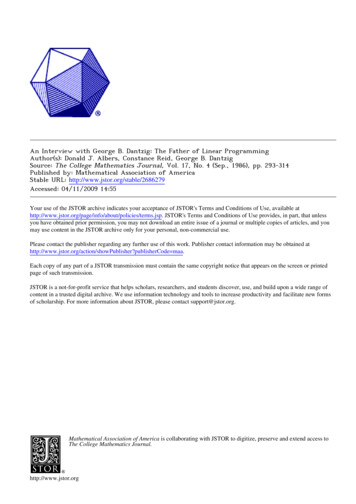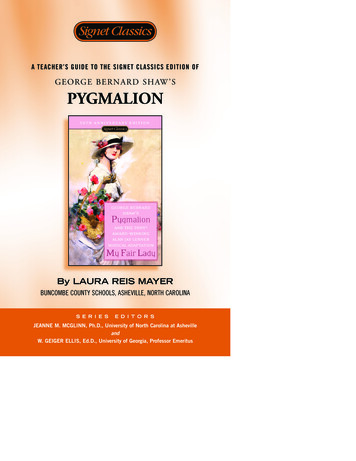
Transcription
A TEACHER’S GUIDE TO THE SIGNET CLASSICS EDITION OFG EORG E B E R N A R D S HAW ’SPYGMALIONBy LAURA REIS MAYERBUNCOMBE COUNTY SCHOOLS, ASHEVILLE, NORTH CAROLINAS E R I E SE D I T O R SJEANNE M. MCGLINN, Ph.D., University of North Carolina at AshevilleandW. GEIGER ELLIS, Ed.D., University of Georgia, Professor Emeritus
2A Teacher’s Guide to the Signet Classics Edition of George Bernard Shaw’s PygmalionTABLE OF CONTENTSAn Introduction .3Synopsis of the Play .3Prereading Activities .6During Reading Activities .13After Reading Activities .21About the Author of this Guide .29About the Editors of this Guide .29Full List of Free Teacher's Guides.30Click on a Classic .31Copyright 2007 by Penguin Group (USA)For additional teacher’s manuals, catalogs,or descriptive brochures, please emailacademic@penguin.com or write to:PENGUIN GROUP (USA) INC.Academic Marketing Department375 Hudson StreetNew York, NY 10014-3657www.penguin.com/academicIn Canada, write to:PENGUIN BOOKS CANADA LTD.Academic Sales90 Eglinton Ave. East, Ste. 700Toronto, OntarioCanada M4P 2Y3Printed in the United States of America
A Teacher’s Guide to the Signet Classics Edition of George Bernard Shaw’s Pygmalion3AN INTRODUCTIONTo a generation of students raised on Disney films, George Bernard Shaw’s Pygmalionis a familiar story: Eliza Doolittle is Cinderella, a beautiful working girl turnedprincess by fairy godmother Henry Higgins. And indeed, Eliza is surrounded bybeautiful ball gowns, horse-drawn carriages, and a handsome young admirer. Yetperhaps it is Pinocchio that is a more accurate comparison. For just as Gepettocreates his puppet and then loses control of his naughty son, so Henry Higgins turnsa flower girl into a lady only to discover she has a will of her own.Beyond its fairy tale aspects, Pygmalion is a social commentary on the systems of educationand class in Victorian England. And most interesting to Shaw himself is the drama’streatment of language, its power, and the preconceptions attached to it by society.Today’s teachers are in an excellent position to share the historic, linguistic, andcultural significance of Pygmalion. In a society where American legislators andlaymen debate the need to make English the official language, and where musicalartists and texting teenagers continue to create dialects of their own, Shaw’s messageis clear: each of us is “a human being with a soul and the divine gift of articulatespeech . . . Our native language is the language of Shakespeare and Milton and TheBible,” and this gift needs to be appreciated. Shaw’s play provides plenty ofopportunity for appreciation, engendering a host of topics for classroom discussion,research, speech, essays, and projects.This guide is designed to assist teachers in planning a unit accessible to readers ofvarious levels and learning styles. Ideas include opportunities for listening, speaking,writing, and creating. Pre-reading activities are provided to prepare students forreading a Victorian play and to challenge students to think about Shaw’s themes.During-reading activities ask students to read more critically. And Post-readingactivities encourage students to evaluate the significance of Pygmalion by analyzingShaw’s style, researching historical and cultural components, and comparing theplay to other works, including Alan Jay Lerner’s My Fair Lady, which is published asa companion piece in the Signet Classics edition. The scope and variety of activitiesoffered in this guide can be used selectively by teachers in focusing on the objectivesof their course and their students.SYNOPSIS OF THE PLAYACT ONEHeavy rain drenches Mrs. Eynsford-Hill and her two adult children, Freddy andClara, as they wait hopelessly for a cab. The Eynsford-Hills and other patrons havejust exited the theatre after a late night show. As Freddie leaves to continue looking,he runs into flower girl Eliza Doolittle. Dressed in dirty rags, Eliza is not shy aboutvoicing her displeasure, and in her loud cockney accent, demands payment for herruined flowers. She is overheard by a gentleman note-taker, who correctly identifiesEliza’s neighborhood simply by listening to her speech. He does the same for various
4A Teacher’s Guide to the Signet Classics Edition of George Bernard Shaw’s Pygmalionbystanders and amazes all, including linguistics expert Colonel Pickering, who hascoincidently traveled to London to meet the famous note taker, phoneticsextraordinaire Henry Higgins. Professor Higgins admonishes Eliza for her “kerbstone”English, and jokingly asserts to Colonel Pickering that “in three months (he) couldpass that girl off as a duchess at an ambassador’s garden party.” Pickering andHiggins leave to discuss phonetics over dinner, and Freddy arrives with a cab onlyto discover his mother and sister have gone home on the bus. Eliza, still reeling fromHiggins’s insults, decides to treat herself to Freddy’s cab with the money Higginsthrew into her flower basket. Eliza arrives at her small and sparse rental room, countsher money, and goes to bed fully dressed.ACT TWOThe next day, Professor Higgins is demonstrating his phonetics equipment toColonel Pickering as both men relax at Higgins’ Wimpole Street laboratory. Mrs.Pearce, Higgins’ housekeeper, announces the arrival of a young woman. Thinking hecan show Pickering how he makes records of his subjects’ voices, Higgins asks Mrs.Pearce to admit the visitor. Cleaned up yet still obviously poor, Eliza enters thestudy. Higgins tells her to leave, but Eliza insists she is there to pay for voice lessonsso she can be a lady in a flower shop instead of a street corner flower girl. Mrs. Pearceadmonishes Eliza for her ignorance and poor manners, but Higgins begins toconsider Eliza’s proposal. Remembering Higgins’s boast, Pickering offers to pay forthe lessons and all expenses if Higgins can fool the party-goers at the ambassador’sgarden party and present Eliza as a lady. Higgins agrees excitedly and orders Mrs.Pearce to get Eliza cleaned up. Eliza balks at this new development, and Mrs. Pearcewarns Higgins that he knows nothing about Eliza’s family, nor has he thought aboutwhat to do with Eliza when the experiment is complete. Higgins is assured he isdoing Eliza a favor, and with a mixture of chocolates and harsh scoldings, he talksher into staying. Mrs. Pearce shows Eliza to a lovely bedroom and bath, and scrubsher roughly despite Eliza’s protests.Meanwhile, Higgins assures Pickering he has only a professional, not a personal,interest in Eliza, as he believes that romantic relationships are too troublesome. Mrs.Pearce warns Professor Higgins that he must watch his language and manners nowif he wishes to serve as a proper model for Eliza. Another visitor soon arrives, thistime Eliza’s alcoholic and spendthrift father, Alfred Doolittle. At first pretending toprotect Eliza’s honor, Doolittle quickly admits he wishes cash in exchange for silenceover Eliza’s living situation. Professor Higgins calls Alfred’s bluff, but is thenimpressed by Doolittle’s tirade against middle class morality. Sensing a kindred,though shameless spirit, Higgins asserts he and Pickering could turn Doolittle intoa politician in three month’s time. After a brief encounter with Eliza, whom he doesnot recognize, Doolittle leaves. The act closes with a sample of the phonetics lessonsthe sobbing Eliza endures for the next several months.ACT THREEThe act opens several months later inside Mrs. Higgins’s drawing room as she expectsvisitors. Her house is tastefully decorated and quite the opposite of her son’s crowded
A Teacher’s Guide to the Signet Classics Edition of George Bernard Shaw’s Pygmalion5quarters. When Higgins arrives without notice, his mother is dismayed and asks himto leave before embarrassing her in front of the impending visitors. Higgins tells hismother about his experiment with Eliza, informing Mrs. Higgins that Eliza will betrying out her new skills in front of his mother’s guests. Next to arrive are Mrs. andMiss Eynsford-Hill, Colonel Pickering, and Freddy. Professor Higgins embarrasseshis mother by belittling small talk, the very purpose of at-home days such as thisone. When Eliza arrives, her audience is impressed. She is exquisitely dressed andappears quite well-bred. Freddy is particularly taken with her. The talk of weatherturns to illness, and Eliza forgets her training when she says her aunt was “done in.”Lapsing totally into her cockney brogue, Eliza astounds her audience. When Higginsattempts to salvage the situation by telling them Eliza’s language is the “new smalltalk,” the Eynsford-Hills are even further impressed. Higgins signals Eliza it is timeshe leaves, and Clara Eynsford-Hill attempts the “new small talk” herself,admonishing “this early Victorian prudery.” Mrs. Higgins tells her son Eliza is notyet presentable, for although her appearance is impeccable, her language still givesher away. Professor Higgins and Colonel Pickering respond by singing Eliza’s praises,boasting about her quick acquisition of dialect and her natural talent on the piano.Echoing Mrs. Pearce’s earlier warning, Mrs. Higgins is concerned about what willbecome of Eliza when the men are finished “playing with (their) live doll.”With the six-month deadline approaching, Eliza is presented at a London Embassy.Professor Higgins is surprised to see one of his former pupils, a man who now makeshis living as an interpreter and an expert placing any speaker in Europe by listeningto his speech. The interpreter speaks to Eliza, and deems her English too perfect foran English woman. The interpreter is further struck by her impeccable manners andannounces Eliza must be a foreign princess. Pickering, Higgins, and Eliza leave,Eliza exhausted and the men exhilarated by winning their bet.ACT FOURThe trio returns to Higgins’s laboratory, the men still bragging about theirexperiment. When Higgins asserts, “Thank God it’s over,” Eliza is hurt. Hurling hisslippers directly at Higgins, Eliza accuses him of selfishness and bemoans what is tobecome of her now that the bet is over. Higgins suggests finding a husband for Eliza,and she is further insulted. Storming out of the house, Eliza encounters Freddy, whohas been pacing, lovelorn, outside her window. Freddy expresses his love, and he andEliza get into a taxi to make plans.ACT FIVEThe next morning, Mrs. Higgins is seated at her drawing-room writing table whenHiggins and Pickering arrive to report Eliza’s disappearance. Reproaching the menfor their treatment of Eliza, Mrs. Higgins is interrupted by the arrival of Eliza’sfather. Alfred Doolittle is dressed like a gentleman and is on his way to his ownwedding. Blaming Professor Higgins for his newly found riches, Alfred explains howHiggins’ letter to the recently deceased Ezra D. Wannafeller led to Doolittle’s sharein the wealthy man’s trust with the provision that Alfred lecture for the MoralReform World League. Doolittle laments the fact that he has to “live for others and
6A Teacher’s Guide to the Signet Classics Edition of George Bernard Shaw’s Pygmalionnot for (him)self: that’s middle class morality.” When Mrs. Higgins announces thatEliza is upstairs, Higgins demands to see the girl. Eliza thanks Colonel Pickering fortreating her like a lady, but accuses Professor Higgins of always thinking of her as aflower girl. Asserting her need for self respect, Eliza says she will not be returninghome to Higgins. As the party leaves to go to Alfred’s wedding, Pickering andHiggins both ask Eliza to reconsider. Higgins admits that he has not treated Elizakindly, but reminds her that he treats all people exactly the same. Admitting that hehas “grown accustomed” to her, Higgins tells Eliza that he wants her to return, notas a slave or a romantic interest, but as a friend. When Eliza asserts that she hasalways been as good as Higgins despite her upbringing, the professor is trulyimpressed. Though the play ends ambiguously, with the possibility of Eliza marryingFreddy, she and Higgins have admitted their non-conventional need for each other,and Eliza has won Professor Higgins’s respect.PRE-READING ACTIVITIESThese activities are designed to deepen students’ background knowledge of Victorianhistory, to widen their comprehension of literary genres and language, and tointroduce them to the play’s major themes. (Note: Consult other Teacher’s Guidesto Signet Classics; they contain ideas that can be adapted to prepare students to readand enjoy this play).I.LITERARY SOURCES AND FORMSBACKGROUND READINGAs a class, read the original story of the sculptor Pygmalion in Ovid’s Metamorphoses.Focus on the relationship between the artist and his creation. Discuss as a class:1.Who is more responsible for Galatea’s “awakening,” Pygmalion or Aphrodite?Explain.2.Because he is her creator, is Pygmalion’s love for Galatea indicative of selfobsession? To what extent is his love ethical?3.What rights of her own does Galatea have?MULTIMEDIA PRESENTATIONOther myths detail artists and their human-like inventions, as well as characters whofall in love with themselves or their own creations. Ask students to read and findthese connections to the Pygmalion legend. In partners, students choose one of thefollowing mythological characters and research Edith Hamilton’s Mythology andother library sources for information to be compiled into a short multimediapresentation. The presentation summarizes the new myth or figure and suggests aconnection to Ovid’s original. While partners share findings with the class, other
A Teacher’s Guide to the Signet Classics Edition of George Bernard Shaw’s Pygmalion7students take notes. The objective is two-fold: whet students’ appetites foruncovering the play’s legendary and timeless intrigue, and provide practice inresearch, writing, and speaking. A topic list is sLITERARY ARCHETYPESIntroduce the different types of literary archetypes with emphasis on the artist aswell as the inventor, the beggar, the fairy godmother (godfather), the quest, and theinitiation. Descriptions and even personality tests to identify students’ own archetypescan be found online and in personality handbooks. Helpful sites /Analytical psychology/agallery of scuss with students:1.2.3.What characteristics define the archetype?Name some artist/orphan/godmother archetypes in literature, film, andsociety. (Consider the film Pretty Woman, which showcases all three.)How are these archetypes perceived in contemporary society? How hasthat perception evolved over time? Explain.ROMANCEDiscuss the genre of romance. Ask students to describe what “romance” typicallymeans. Answers will probably include “a love story” and “chick flicks.” Make a liston the board or overhead of books and movies the students have read or seen thatwould fall under the “romance” category. Remind the class that “romantic comedies”are a literary tradition dating back to Shakespeare. Ask students if they have read orseen Much Ado About Nothing, or A Midsummer Night’s Dream. Discuss the mix ofhumor and male-female relationship issues that is central to these works, and thatwhile a “romance” to some is simply a love story, a “romantic comedy” delves intodeeper issues about human relationships while maintaining a witty tone.Explain to students that Victorian romances are more along these lines, that inaddition to the witty dialogue and the relationships between men and women,Victorian romances such as Pride and Prejudice and Jane Eyre also set out to examinesocial issues, and often showcase leading ladies who are impoverished yet inherentlymoral, and male protagonists who learn that money and character do not necessarilygo hand in hand. George Bernard Shaw is a Victorian playwright who makes thesesame issues central to Pygmalion: A Romance in Five Acts.
8A Teacher’s Guide to the Signet Classics Edition of George Bernard Shaw’s PygmalionSHAVIAN DRAMAShavian (referring to Shaw) drama is the type of politically and socially charged“discussion play” made popular by George Bernard Shaw and his contemporary,Oscar Wilde. Shavian theater is in direct contrast to the simplistic fare deplored byShaw and typically found on the Victorian stage. For background on Shaw’sphilosophical and literary ideals, ask students to read Richard H. Goldstone’s“Introduction” and “George Bernard Shaw: Pygmalion” in the Signet ClassicsEdition of Pygmalion.II. KNOWLEDGE OF VICTORIAN HISTORY AND CULTUREVICTORIAN WEB QUESTIndividually or in groups, students can use the internet to delve into Victorianhistory and culture. Teachers can create their own topics and links, or they canutilize web resources already available. Topics might include Victorian education,marriage, language, social reform, theatre, and clothing.These links provide a starting point: ess.com/History/Victorian NOTATED BIBLIOGRAPHYPygmalion references many artists, designers, architecture, and traditions significantin Victorian England. Give students a list of items specifically referenced inPygmalion. Ask them to research each item and create a bibliographic entry for everysource they use as well as a paragraph detailing the information that the sourceprovides. Later, while reading the play, students can discuss their findings when thetopic is referenced in the text.1.2.3.4.5.6.7.8.9.10.Covent Garden (5)Inigo Jones (5)St. Paul’s Church (5)Sir Christopher Wren (5)St. Paul’s Cathedral (5)Cecil Lawson (51)William Morris (51)Edward Burne-Jones (51)“at-home day” (51)navvy (47)
A Teacher’s Guide to the Signet Classics Edition of George Bernard Shaw’s Pygmalion9ART CRITICISMOn PowerPoint or similar computer slide program, show students a collection ofpaintings and sculptures that depict Pygmalion and Galatea. As each piece is shown,ask students to draw a thumbnail sketch for their notes, and then write a briefdescription and a brief analysis. After the viewing is complete, ask students to reflecton the works as a whole. Do they share any patterns in style, subject matter, ortheme? Discuss the relationship between the artist and his creation. A collection ofpossible works appears below.1.Goya’s Pygmalion and Galatea (1812)2.Falconet’s Pygmalion and Galaté (1763)3.Burne-Jones four part series of Pygmalion (1868-1870); (1875-1878)4.Gerome’s Pygmalion and Galatea (1890)5.Rodin’s Pygmalion et Galatée (1908)AUTHOR TIMELINESeveral ideas in Pygmalion (such as Higgins’ socialistic beliefs) have direct parallelsto Shaw’s personal history. Ask students to create a timeline based on GeorgeBernard Shaw’s life and career. The information can be found in many BritishLiterature textbooks or in a print or online encyclopedia. Timelines can be handdrawn, word-processed, or digitally produced. Make sure to ask students to leaveroom to add information, because during the reading of the text, they can makeconnections between the play and Shaw’s life.III. KNOWLEDGE OF LANGUAGEPHONETIC ALPHABETSShaw asserted that Pygmalion is actually about phonetics. And his will included asuggestion that an alternate English alphabet be written in phonetics, and that a contestbe held to produce it. He even offered money from his estate to encourage contestentries. The winner was Kinsley Read, who named the Shaw alphabet “Shavian.”Have students study the Shavian alphabet and the International Phonetic Alphabet,(IPA) and practice writing some of the symbols. Links appear htmhttp://www.omniglot.com/writing/ipa.htmFor further enrichment, ask students to translate a line from a famous poem or songinto one of the phonetic alphabets. Students can switch and challenge each other toread the phonetic verses.
10A Teacher’s Guide to the Signet Classics Edition of George Bernard Shaw’s PygmalionPARODYAsk students to read Pygmalion’s opening scene, where Higgins guesses bystanders’neighborhoods from their accents. Next, have students “translate” the scene for anaudience of 21st century young adults by altering diction, syntax, and style, butmaintaining Shaw’s plot and meaning. Students might choose to place Higgins inthe Wild West, or in the contemporary South, or on the streets of New York.Bystanders’ accents will change accordingly. Students might even choose to write thescene in “texting” or “Instant Message” (IM) language. This activity strengthens skillin audience, purpose, and comprehension, and can also be used as a directed readingor post-reading assessment.COMPARISON/CONTRASTSince Shaw’s favorite authors were Shakespeare and Milton, read aloud a monologuefrom Hamlet and from Paradise Lost (or other selections). Then read moderntranslations of both pieces. Links are found below. Ask students:1.What survives the translation?2.What is lost in translation?3.Is plot the most important message the author wants us to receive?4.What stylistic characteristics define each writer? Do these characteristicsappear in the translation? http://www.paradiselost.org/index-2.html http://nfs.sparknotes.com/hamlet/page 18.eplIV. INITIAL EXPLORATION OF THEMESSOCIAL CLASSES AND DISTINCTIONSTREE DIAGRAMWrite the words “social class” on the board and enclose them in a rectangle. Askstudents to name social classes they believe exist in today’s society. Write theirresponses in rectangles directly under the main topic and connect them to theoriginal with lines. Encourage students to develop the diagram more fully byassigning perceived characteristics and behaviors to each of these classes. Discussion:Why do these distinctions exist? How has the class system in America changed overthe years? Can Americans move from one class to another, or are there restrictions?ROLE PLAYAssign partners a scenario where one student coaches the other in preparation for asocial event. For example, one student helps his partner prepare for a state dinner atthe White House. What clothes should she wear? How should she speak? Whichforks go with what food? Another group could prepare for a barbeque at a friend’shouse. Ask partners to stage an impromptu scene with each other. Afterwards, ask
A Teacher’s Guide to the Signet Classics Edition of George Bernard Shaw’s Pygmalion11partners to discuss their choices with the class. Why were the dress and language atthe barbeque less formal? Emphasize social class distinctions and expectations.DIRECTED READING ACTIVITYRead aloud with students the first scene of Pygmalion. Ask them to take note of anydescriptions or dialogue that indicates class differences. For example, students mightwrite down Eliza and Doolittle’s contrasting outfits, or the difference in dialectbetween the flower girl and the theatre patrons. After the reading is complete,compile a class list on the board and discuss connections to contemporary society.To what extent do clothes still “make the man”? Should it matter how a personspeaks? Why and in what circumstances?SOCIALISMFREE WRITINGGive students a set time period to respond to one of the following prompts inwriting, and then share with a partner or the class.1.Is education a right or a privilege? Is there a time when we have the rightto deny education? Whose responsibility is it to place graduating studentsin college, careers, or training paths?2.To what extent does money equal social class in America? Can you thinkof anyone who has money but lacks “class”? Discuss.3.If two job candidates are equal in education and experience, is it fair tooffer the job to the candidate who presents a more polished image? Howis this image related to class?INTRODUCTORY READING1.Ask students to read the foreword to Pygmalion in the Signet Classicsedition. Point out the passage that says, “Pygmalion has as its subjecttheme the institutions man has constructed to help perpetuate both theprivileges of the rich and the servility of the poor”(xi). Ask students whatsome of these institutions are in contemporary society. Language?Education? Housing? Discuss.2.Ask students to read the article “The Fabian Society,” which details Shaw’sutopian socialist philosophy. The link is found below. Ask them to findand record the following information. What are the essential beliefs ofFabian Socialism? Name three famous Fabian Society Members. How didFabians differ from Marxists? What was their time frame for action? tm
12A Teacher’s Guide to the Signet Classics Edition of George Bernard Shaw’s PygmalionTHE POWER OF LANGUAGEDEBATEDivide the class into two groups. One group will argue the significance of formalspoken English; the other will support the importance of conversational English.Ask each side to prepare supporting points, as well as predict what the opposing sidewill say. Allow students to use both personal and academic evidence. For example,students might reference the current debate on English as the official language of theU.S., or they might defend the use of instant messenger shorthand when chattingwith friends online. Challenge them to make connections to their own lives. Holda class debate, complete with cross-examinations and rebuttals.LOST IN TRANSLATIONRead aloud in class Elizabeth Barrett Browning’s Sonnet XLIII, “How Do I LoveThee.” Discuss the impact of its formal tone and diction. Now ask students to“translate” the sonnet into modern slang or hip-hop lyrics. Share the results anddiscuss the impact of the language changes. Can the same feeling be expressed withvastly different word choice?LANGUAGE LAW 101Ask students to take the role of a college professor, designing a handout for a course inlanguage law. They must prepare a list of do’s and don’ts for speaking in formalsociety. Tell students to include penalties for broken laws, such as what happens whensomeone uses a double negative or offensive language in formal society. Lists may becompiled individually or in groups and can be photocopied and shared with the class.THE ARTIST’S DILEMMAFILM CLIPShow students the clip from Disney’s Pinocchio where Gepetto’s wish comes true andhis puppet turns into a real boy, who is warned by the Blue Fairy that he needs tofully understand himself prior to being considered “human.” A discussion of thescene is an excellent introduction to the idea of the Artist’s Dilemma.Discuss with students:1.What archetypal roles are played by Gepetto, Pinocchio, and the BlueFairy?2.Is Gepetto’s wish for his puppet to become real an ethical desire?3.What is the role of an artist in reference to his work? Should he be able tocontrol his art, or to control the outside world’s reactions to it? At whatpoint must the artist abandon his creation?THINK, PAIR, SHAREDiscuss with the class the fascination the public still maintains with Leonardo DaVinci’s 500-year-old Mona Lisa. For centuries audiences have argued the meaning of
A Teacher’s Guide to the Signet Classics Edition of George Bernard Shaw’s Pygmalion13her enigmatic smile. Dan Brown’s bestselling The Da Vinci Code asserts that DaVinci ascribed countless hidden messages and meanings to this work, and that thepainting is much more than simple representative art. Yet the fact remains that theartist cannot tell us for sure. And so we are left with the eternal question, does theartist lose control of his art the minute it leaves his brush, pen, or mold? Does theaudience have a right to interpretation? Can the art take on a life of its own? Moreimportantly, should it? Ask students to respond in writing after thinking about thesequestions, then find a partner and share responses.DURING READING ACTIVITIESThese activities invite students to examine the text more closely and to think, speak,and write analytically about the themes and issues introduced in the pre-readingactivities. Whether the play is read aloud in class or silently at home, teachers canchoose appropriate assignments from the ideas below.I.ANALYZING THROUGH INDIVIDUAL RESPONSEQUOTATION JOURNALS (ELECTRONIC OR HANDWRITTEN)Quotation journals encourage students to take a second look while reading and toread for analysis, not simply plot. The best journals are composed as the studentreads, not after the reading is completed. In this way students prove to themselvesand their teachers that they are thinking as they read. Whether handwritten orelectronic journals that students submit via email, teachers can add commentsthroughout, responding personally to ideas students may not be willing to verbalizein class.Ask students to find one or more significant quotations from each act in Pygmalion,and then write down or type their quotations. After each quotation, students analyzein a short paragraph why they found the quotation significant. They might comment onpatterns they see developing, themes they see evolving, social or historical commentarythey see being made, or connections they believe tie the play to modern society. Asthe journal progresses, students should see their notes falling into categories thatillustrate their comprehension of Shaw’s significant themes and issues.Later, quotation journals can be used to initiate student-led discussions in class. Askstudents: “Who would like
To a generation of students raised on Disney films, George Bernard Shaw's Pygmalion is a familiar story: Eliza Doolittle is Cinderella, a beautiful working girl turned princess by fairy godmother Henry Higgins. And indeed, Eliza is surrounded by beautiful ball gowns, horse-drawn carriages, and a handsome young admirer. Yet
